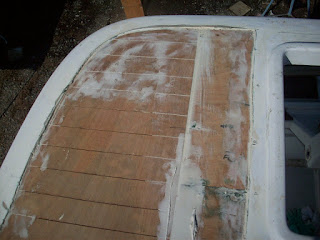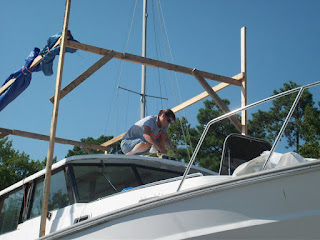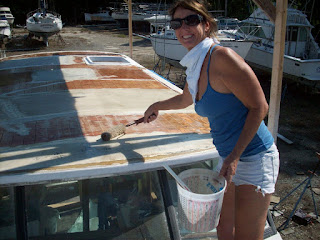I (kinda) feel like a pro now...HUGE difference from last week to this week in my expertise! And Shawn bears the lion's share of the chore since he has to grind all the mistakes made to be redone! Love that man so much!!! He is so very talented and patient!
So when we got to our YB, "we" pulled the tarp over the Shawn Fay patented clever "awning for working on a boat deck coring" so that the work area would be shaded.

When we inspected the fiberglass from last week, we found that we had made many mistakes in that we had not completely rolled out the air bubbles that form with the resin application that laminates the fiberglass biaxial cloth. Oops! a big oops since Shawn had to grind out all the mistakes!

Last week, with the first layer application we worked from side to side (athwartship) of the deck. This week we alternated and went "bowling alley" fore to aft. Much much easier and faster in my opinion! (IF I had MY way, we would ONLY do fore to aft).
We cut the fiberglass mat the entire length of the bridge (2 lengths) and then dry-fitted the hatch side since we had to cut out the hatch portion before glassing. We also learned from last week to trim the fiberglass to the edge of the deck as it is a huge pain to grind the overlap off!
Because the sun was not directly overhead, we hung another tarp off the side to complete shade the deck. Not so much for our temperature comfort (tho it does help but to prevent the resin from hardening too quickly.
We developed a pretty good system and rhythm. Shawn would mix and simply pour the resin on an area (we eliminated using a roller tray), then I would spread it with the paint roller so that it soaked the fibers, then I would smooth it out with the "bubble buster". Shawn was in charge of spotting any places I missed. Oh and I wore gloves this week! We worked fore to aft on the hatch side. It came out really well!
After completing the hatch side, we simply moved over to the other side and worked aft to fore. We learned (after consulting with the extremely knowledgeable Larry Jennings) to ensure that where the two seams of the cloth overlap:
(1) make sure there is at least an inch of overlap
(2) only roll in one direction (towards the edge of the fabric).
If you roll back and forth (which was MY natural tendency), the fabric pulls up and bubbles. Bubbles=bad
We weighed the cloth with 2*4 timbers to keep it secure until we applied the resin mixture.The final product looks great!!!



























































